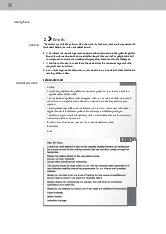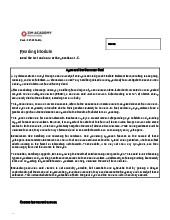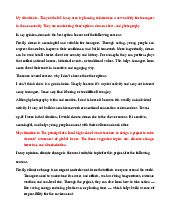








Preview text:
lOMoAR cPSD| 59561451 U5 – Reading 1
You are going to read an article about a list of books for teenage readers. For questions 1-6,
choose the answer (A, B, C or D) which you think fits best according to the text.
World Book Day – the test teen reads
by Genny Haslett, 24, English literature teacher at Bathampton Secondary School
It is often suggested that teachers and librarians aren’t pushing secondary school
readers towards titles that challenge them enough, and so the organisers of World Book Day
have announced a list which might provide some inspiration for anyone who’s stuck for ideas.
This list of popular books for young adults, voted for by 10,000 people across the UK, features a
top 10 to ‘shape and inspire’ teenagers, and handle some of the challenges of adolescence.
All but one of the books have already been made into films, demonstrating that when a
book makes it to the big screen, it often then acquires more readers thanks to the film’s success.
Of course, this isn’t always the case, as with George Orwell’s 1984, where the rather mediocre
film does not compare so favourably with the book’s ability to conjure up a dark vision of life in a police state.
James Bowen’s A Streetcat Named Bod, published in 2012, is one of the few relatively
contemporary books here. It’s also certainly for me the least predictable member of the list, but
its extended stay on the bestseller list earned it – and its author – a devoted following. It is the
touching story of Bob, the cat who helped a homeless man called James get his life back on
track. Bob sits on James’s shoulder and sleeps at his feet while he plays the guitar on the street,
and soon becomes the centre of attention. What makes the story particularly powerful is that it
is based on author James Bowen’s real life.
Also on the list are J. K. Rowling’s Harry Potter books. In this case it’s actually the whole
series rather than one particular title that makes the shortlist. Perhaps the judges struggled to
agree which one book to pick. For me, the books are rather more pre-teen than the rest of the
books on the list, which are aimed at a more mature readership.
But Harry Potter is a special case: as Harry gets older in each successive book in the
series, the stories do become more complex and darker. In a way, readers themselves grow up
with Harry and his friends. Rowling asks some tough questions about standing up to authority,
challenging ‘normal’ views and many other subjects close to teenage readers’ hearts. This
should get rid of the idea that the whole series is just for young kids. In actual fact, half of all
Harry Potter readers are over the age of 35, but that’s another story.
The list goes right back to the nineteenth century with Charlotte Bronte’s great romance
Jane Eyre, showing that some books never grow old, though the majority are twentieth-century
works such as Anne Frank’s heartbreaking wartime memoir The Diary of a Young Girl, which
even now I find hard to get through without shedding tears. Personally, I would have swapped J.
R. R. Tolkien’s The Lord of the Rings for one of the many classics that didn’t make the final
selection, Lord of the Flies perhaps, William Golding’s nightmare vision of schoolboys stuck on an island. lOMoAR cPSD| 59561451
Of course there’ll always be some choices we don’t agree with, but that’s what I think
makes a list like this so fascinating. I’ve been using it with my class of 16-year-olds, and I got
them to evaluate it and make other suggestions for what to include or how it could be changed.
But what I hope can really make a lasting difference is if it stimulates them to try out writers on
the list, perhaps ones they haven’t come across before, and be introduced to new styles of writing. 1
What criticism does the writer make in the first paragraph?
A World Book Day has been poorly organised.
B School librarians aren’t working hard enough.
C Teenagers are reading books that are too easy.
D Teachers don’t encourage pupils to read enough. 2
What point is made about books which are made into films?
A The best books tend to be made into films.
B The film of a book makes more people read the book.
C Many people prefer to watch a film than read the book.
D It is useful to be able to compare the book and the film. 3
What does the writer suggest about A Streetcat Named Bob?
A She is surprised that it is on the list.
B The book did not sell as well as it deserved to.
C It is the most recently published book on the list.
D It is the only autobiography on the list. 4
How does the writer justify the presence of the Harry Potter books on the list?
A The books’ fame can help the list get more attention.
B The later books in the series are more suitable for teenagers.
C Teenagers should read books that they will also enjoy as adults.
D It makes sense to have a whole series as well as individual books. 5
Which book does the writer feel shouldn’t be on the list? A Jane Eyre
B The Diary of a Young Girl
C The Lord of the Rings
D Lord of the Flies 6
What does the writer intend to do?
A be more fully developed in future
B prompt pupils to read more widely
C enable pupils to write more effectively
D provide a useful topic for discussion in classU5 – Reading 2
Children’s literature A
I am sometimes asked why anyone who is not a teacher or a librarian or the
parent of little kids should concern herself with children's books and folklore. I know the
standard answers: that many famous writers have written for children, and that the great lOMoAR cPSD| 59561451
children's books are also great literature; that these books and tales are an important source of
archetype and symbol, and that they can help us to understand the structure and functions of the novel. B
All this is true. But I think we should also take children's literature seriously
because it is sometimes subversive: because its values are not always those of the conventional
adult world. Of course, in a sense much great literature is subversive, since its very existence
implies that what matters is art, imagination and truth. In what we call the real world, what
usually counts is money, power and public success. C
The great subversive works of children's literature suggest that there are other life besides views of human
those of the shopping mall and the corporation. They mock
current assumptions and express the imaginative, unconventional, noncommercial view of the
world in its simplest and purest form. They appeal to the imaginative, questioning, rebellious
child within all of us, renew our instinctive energy, and act as a force for change. This is why
such literature is worthy of our attention and will endure long after more conventional tales have been forgotten. D
An interesting question is what - besides intention - makes a particular story a
'children's book'? With the exception of picture books for toddlers, these works are not
necessarily shorter or simpler than so-called adult fiction, and they are surely not less well
written. The heroes and heroines of these tales, it is true, are often children: but then so are the
protagonists of Henry James's What Maisie Knew and Toni Morrison's The Bluest Eye. Yet the
barrier between children's books and adult fiction remains; editors, critics and readers seem to
have little trouble in assigning a given work to one category or the other. E
In classic children's fiction a pastoral convention is maintained. It is assumed that
the world of childhood is simpler and more natural than that of adults, and that children,
though they may have faults, are essentially good or at least capable of becoming so. The
transformation of selfish, whiny, disagreeable Mary and hysterical, demanding Colin in Frances
Hodgson Burnett's The Secret Garden is a paradigm. Of course, there are often unpleasant
minor juvenile characters who give the protagonist a lot of trouble and are defeated or evaded
rather than reeducated. But on occasion even the angry bully and the lying sneak can be
reformed and forgiven. Richard Hughes's A High Wind in Jamaica, though most of its characters
are children, never appears on lists of recommended juvenile fiction; not so much because of
the elaborations of its diction (which is no more complex than that of, say, Treasure Island), but
because in it children are irretrievably damaged and corrupted. F
Adults in most children's books, on the other hand, are usually stuck with their
characters and incapable of alteration or growth. If they are really unpleasant, the only thing
that can rescue them is the natural goodness of a child. Here again, Mrs. Burnett provides the
classic example, in Little Lord Fauntleroy. (Scrooge's somewhat similar change of heart in
Dickens's A Christmas Carol, however, is due mainly to regret for his past and terror of the lOMoAR cPSD| 59561451
future. This is one of the things that makes the book a family rather than a juvenile romance;
another is the helpless passivity of the principal child character, Tiny Tim.). G
Of the three principal preoccupations of adult fiction - sex, money and death -
the first is absent from classic children's literature and the other two either absent or much
muted. Money is a motive in children's literature, in the sense that many stories deal with a
search for treasure of some sort. These quests, unlike real-life ones, are almost always
successful, though occasionally what is found in the end is some form of family happiness,
which is declared by the author and the characters to be a 'real treasure'. Simple economic
survival, however, is almost never the problem; what is sought, rather, is a magical (sometimes
literally magical) surplus of wealth. Death, which was a common theme in nineteenth-century
fiction for children, was almost banished during the first half of the twentieth century. Since
then it has begun to reappear; the breakthrough book was E.B. White's Charlotte's Web. Today
not only animals but people die, notably in the sort of books that get awards and are
recommended by librarians and psychologists for children who have lost a relative. But even
today the characters who die tend to be of another generation; the protagonist and his or her
friends survive. Though there are some interesting exceptions, even the most subversive of
contemporary children's books usually follow these conventions. They portray an ideal world of
perfectible beings, free of the necessity for survival. Questions 1-7
Reading Passage has seven paragraphs A-G.
Choose the correct heading for each paragraph from the list of headings below. List of Headings
i Optimistic beliefs held by the writers of children’s literature ii The
attitudes of certain adults towards children’s literature iii The attraction of
children’s literature iv A contrast that categorises a book as children’s
literature v A false assumption made about children’s literature vi The
conventional view of children’s literature vii Some good and bad features of
children’s literature viii Classifying a book as children’s literature
ix The treatment of various Themes in children’s literature x Another
way of looking at children’s literature 1 Paragraph A vi 2 Paragraph B x 3 Paragraph C iii 4 Paragraph D viii 5 Paragraph E i 6 Paragraph F iv 7 Paragraph G ix Questions 8-13 lOMoAR cPSD| 59561451
Do the following statements agree with the views of the writer in Reading Passage?
YES if the statement agrees with the views of the miter
NO if the statement contradicts the views of the writer
NOT GIVEN if it is impossible to say what the writer thinks about this
8 Adults often tail to recognise the subversive elements in books their children read. NG
9 In publishing, the definition of certain genres has become inconsistent. NO 10 Characters in
The Secret Garden are a good example of the norm in children’s literature. YES
11 Despite the language used in A High Wind in Jamaica, it should be considered a children’s book. NO
12 The character of Tiny Tim contrasts with that of the child in Little Lord Fauntleroy. YES
13 A more realistic view of money should be given in children’s books. NG U5 – Reading 3
You are going to read an article about a language. Six sentences have been removed from the
article. Choose from the sentences A-G the one which fits each gap (1-6). There is one extra
sentence which you do not need to use.
I’m the last speaker of my language
I come from Chile and I’ve always been interested in my country’s history and culture. It
all started when I was about eight and I started to learn about the country’s indigenous
inhabitants. When I first found out about the native people of Patagonia, in the far south, I had
no idea that my mother’s family was from there and that her grandfather had been a Selk’nam.
The last speaker of Selk’nam died in 1974. I really wanted to learn Selk’nam, so relatives on my
father’s side who live in Punta Arenas, the southernmost town in mainland Chile, sent me
dictionaries. (1)………… But I had no idea what these sounded like.
Then, when I was about eleven, I saw a television programme about the Yagán people
who lived on the island of Tierra del Fuego, the southernmost tip of South America. The
programme interviewed two sisters, Cristina and Ursula Calderón, and said they were the only
two speakers of their language left. (2)………… Only later did I discover that the two languages
are quite different; that the two peoples couldn’t communicate with each other.
One day, my mother told me that although she was born in the capital, Santiago, her
grandfather was a Selk’nam from the north of Tierra del Fuego. Nobody had ever told me
anything about this before. When I asked why, she said that when she was young she had been
teased for looking different, and so she had just kept quiet about it.
When I was thirteen, I went to the south for the first time on my own to meet Cristina
Calderón. (3)………… I discovered that there used to be four thousand Selk’nam in Tierra del
Fuego. They were hunters of wild cats and foxes. The Yagán lived further south and travelled by
canoe all the way down to Cape Horn, but the Selk’nam moved on foot.
Settlers from the north arrived in the nineteenth century and introduced diseases like
measles and typhoid, which affected the local people very badly. Now, there’s no way back. I got
hold of some recordings of a Selk’nam shaman from the 1960s and started to study them. lOMoAR cPSD| 59561451
(4)………… Gradually, however, I began to understand how the words sounded and began to reproduce them.
The Selk’nam express themselves using lots of prefixes and suffixes, and the sounds are
guttural, nasal and tonal. (5)………… For example, it has lots of different words for the weather.
The hardest thing in Selk’nam, however, is the verbs – they all sound a bit the same. There are
some English loanwords, such as ‘bread’ and ‘money’. Others are descriptive: ‘read’ translates
as ‘playing with words’ and ‘drum’ as ‘vibrating leather’. Then there are words for modern
things – for ‘telephone’, you have to say ‘speak from afar’, and ‘car’ is ‘go on four wheels’. I
speak the language well now. Cristina’s husband spoke Selk’nam and apparently I sound just like him.
Because music is something that reaches lots of people, I started composing traditional
songs in Selk’nam and formed a band with two friends. This meant that they had to learn some
words, too. (6)………… I need to teach my language to more people because if something
happened to me, it would die out all over again.
A I felt a sudden desire to learn that one too.
B It was slow because I had no one to talk to.
C Yagán is quite different, however, because it has more vocabulary.
D This meant that I was able to start learning words, verbs and expressions. E
This was good because I didn’t want to be the only one. F
These turned out to be rather hard for me to pronounce, however.
G The trip seemed the best way to find out about my roots. U5 – Reading 4
Reading in a whole new way
As technology improves, how does the act of reading change?
Reading and writing, like all technologies, are constantly changing. In ancient times,
authors often dictated their books. Dictation sounded like an uninterrupted series of words, so
scribes wrote these down in one long continuous string, justastheyoccurinspeech. For this
reason, text was written without spaces between words until the 11th century.
This continuous script made books hard to read, so only a few people were
accomplished at reading them aloud to others. Being able to read silently to yourself was
considered an amazing talent; writing was an even rarer skill. In fact, in 15th-century Europe,
only one in 20 adult males could write.
After Gutenberg’s invention of the printing press in about 1440, massproduced books
changed the way people read and wrote. The technology of printing increased the number of
words available, and more types of media, such as newspapers and magazines, broadened what was written about.
Authors no longer had to produce scholarly works, as was common until then, but could write,
for example, inexpensive, heart-rending love stories or publish autobiographies, even if they were unknown. lOMoAR cPSD| 59561451
In time, the power of the written word gave birth to the idea of authority and expertise.
Laws were compiled into official documents, contracts were written down and nothing was valid
unless it was in this form. Painting, music, architecture, dance were all important, but the
heartbeat of many cultures was the turning pages of a book. By the early 19th century, public
libraries had been built in many cities.
Today, words are migrating from paper to computers, phones, laptops and game
consoles. Some 4.5 billion digital screens illuminate our lives. Letters are no longer fixed in black
ink on paper, but flitter on a glass surface in a rainbow of colors as fast as our eyes can blink.
Screens fill our pockets, briefcases, cars, living-room walls and the sides of buildings. They sit in
front of us when we work - regardless of what we do. And of course, these newly ubiquitous
screens have changed how we read and write.
The first screens that overtook culture, several decades ago - the big, fat, warm tubes of
television - reduced the time we spent reading to such an extent that it seemed as if reading
and writing were over. Educators and parents worried deeply that the TV generation would be
unable to write. But the interconnected, cool, thin displays of computer screens launched an
epidemic of writing that continues to swell. As a consequence, the amount of time people
spend reading has almost tripled since 1980. By 2008, the World Wide Web contained more
than a trillion pages, and that total grows rapidly every day.
But it is not book reading or newspaper reading, it is screen reading. Screens are always
on, and, unlike books, we never stop staring at them. This new platform is very visual, and it is
gradually merging words with moving images. You might think of this new medium as books we
watch, or television we read. We also use screens to present data, and this encourages
numeracy: visualising data and reading charts, looking at pictures and symbols are all part of this new literacy.
Screens engage our bodies, too. The most we may do while reading a book is to flip the
pages or turn over a corner, but when we use a screen, we interact with what we see. In the
futuristic movie Minority Report, the main character stands in front of a screen and hunts
through huge amounts of information as if conducting an orchestra. Just as it seemed strange
five centuries ago to see someone read silently, in the future it will seem strange to read without moving your body.
In addition, screens encourage more utilitarian (practical) thinking. A new idea or
unfamiliar fact will cause a reflex to do something: to research a word, to question your screen
‘friends’ for their opinions or to find alternative views. Book reading strengthened our analytical
skills, encouraging us to think carefully about how we feel. Screen reading, on the other hand,
encourages quick responses, associating this idea with another, equipping us to deal with the
thousands of new thoughts expressed every day. For example, we review a movie for our
friends while we watch it; we read the owner’s manual of a device we see in a shop before we
purchase it, rather than after we get home and discover that it can’t do what we need it to do. lOMoAR cPSD| 59561451
Screens provoke action instead of persuasion. Propaganda is less effective, and false
information is hard to deliver in a world of screens because while misinformation travels fast,
corrections do, too. On a screen, it is often easier to correct a falsehood than to tell one in the
first place. Wikipedia works so well because it removes an error in a single click. In books, we
find a revealed truth; on the screen, we assemble our own truth from pieces. What is more, a
screen can reveal the inner nature of things. Waving the camera eye of a smartphone over the
bar code of a manufactured product reveals its price, origins and even relevant comments by
other owners. It is as if the screen displays the object’s intangible essence. A popular children’s
toy (Webkinz) instills stuffed animals with a virtual character that is ‘hidden’ inside; a screen
enables children to play with this inner character online in a virtual world.
In the near future, screens will be the first place we’ll look for answers, for friends, for
news, for meaning, for our sense of who we are and who we can be.
Questions 1-5 Choose the correct letter, A, B, C or D. 1
What does the writer say about dictation?
A It helped people learn to read.
B It affected the way people wrote.
C It was not used until the 11th century.
D It was used mainly for correspondence. 2
According to the writer, what changed after the invention of the printing press?
A Romance became more popular than serious fiction.
B Newspapers became more popular than books.
C Readers asked for more autobiographies.
D Authors had a wider choice of topics. 3
In the third paragraph, the writer focuses on the A legal concerns of authors.
B rapid changes in public libraries.
C growing status of the written word.
D recognition of the book as an art form. 4
What does the writer say about screens in the fourth paragraph?
A They are hard to read.
B They are bad for our health.
C They can improve our work.
D They can be found everywhere. 5
According to the writer, computers differ from television because they A encourage more reading.
B attract more criticism.
C take up more of our leisure time.
D include more educational content.
Questions 6-10 Do the following statements agree with the views of the writer in Reading Passage 3? lOMoAR cPSD| 59561451 Write
YES if the statement agrees with the views of the writer
NO if the statement contradicts the views of the writer
NOT GIVEN if it is impossible to say what the writer thinks about this 6 Screen reading has
reduced the number of books and newspapers people read. 7
Screen literacy requires a wider range of visual skills than book-based literacy. 8
Screen reading is more active than book reading. 9
Screens and books produce similar thought patterns in their readers.
10 People are easily persuaded to believe lies on the screen.
Questions 11-14 Complete each sentence with the correct ending, A-F, below.
11 The film Minority Report illustrates
12 Our behaviour when we watch a film shows
13 Wikipedia’s success relies on
14 Webkinz is an example of
A the accuracy of its information.
B people’s ability to concentrate.
C the global use of the Internet.
D how people behave physically when they read screens.
E the screen’s ability to make an object seem real. F how rapidly opinions can be communicated.




